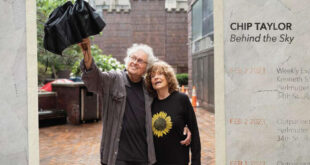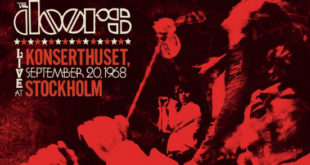Coming October 29 from Universal Pictures is Taylor Hackford’s highly anticipated biopic on the life of Ray Charles, Ray, starring Jamie Foxx as the legend. Check out a touching, exciting trailer for the film here or here. Jamie Foxx would appear to give a remarkable performance.
The soundtrack to the film is equally remarkable, featuring 17 Ray Charles classics, the limited-edition package includes a bonus DVD with four performance clips by Foxx as Charles. You can listen to the entire album here.
It’s a strange and amazing time for Charles, who died June 10 at the age of 73: he is arguably more popular and visible now than at any time since the mid-’60s, with the forthcoming film, the release at the end of August of his platinum duets record, Genius Loves Company, and of course the sea of tributes surrounding his death.
Here was mine:
Ray Charles – the Genius, the High Priest of Soul – who died today at 73, did two things that tower above his other manifest accomplishments: he wrapped his arms more powerfully than any other artist around the width and breadth of American musical forms and drew them together into something beautifully and soulfully his own, and in doing this he embodied contradictions as extreme as the American experience itself.
The contradictions and broad musical reach began in his childhood in Albany, Georgia, and Greenville, Florida, where his family was poor and the Depression deep. The standard difficulties of poverty and black life in a segregated South escalated to tragedy when at five Charles witnessed the drowning death of his brother in his mother’s take-in laundry tub, and at six lost his sight to (presumably) glaucoma. Given a choice, I imagine he would have chosen the order of the tragedies reversed: imagine such a sight seared into your brain with nothing to replace it for the next 68 years of your life.
And yet for all the blunt force of the hand of fate, Charles’s early life was also touched with refinement and delicacy: he was sent away at age seven to the St. Augustine School for the Deaf and Blind, where he learned to read, write and arrange music in Braille, score for big bands, and play piano, organ, sax, clarinet, trumpet under the influence of such notable musical sophisticates as big band clarinetist Artie Shaw, jazz piano giant Art Tatum, and classical composers Chopin and Sibelius. But at night, in the dark, he also loved to listen to the raw melodies and hillbilly twang of the Grand Ole Opry on the radio, and to the sanctified abandon of gospel and the secular soul-venting of the blues.
At 15 he graduated from St Augustine’s and hit the road, Jack, as a musician and heroin addict (a monkey he wouldn’t kick off his back for another 20 years) playing the chitlin circuit around Florida. But while his life was rough — a blind junkie teenage musician trying to eke out a living in the South of the mid-’40s — his music was sophisticated, even gentle – he played the popular elegant piano cocktail swing of the day and crooned smoothly, perhaps attempting to calm the savage beast without and within.
Then at 17, a diametric geographical move (another contradiction) sent him to Seattle, Washington, where he met and taught arrangement to lifelong friend Quincy Jones. He began recording, in Los Angeles for Swing Time, then in New York for Atlantic. He played with blues great Lowell Fulson, backed Ruth Brown and even Moms Mabley, all the while performing and singing ably but, frankly, generically. It wasn’t until 1953 — in yet another city, New Orleans — that the young man finally became RAY CHARLES, after playing piano and arranging for ragged bluesman Guitar Slim, including Slim’s million-selling recording “The Things I Used to Do.”
Suddenly, on “Don’t You Know” and especially on “I’ve Got a Woman,” the tumblers fell into place: the call and response between vocals and horns, the compression creating a tougher, thicker vocal sound, the gospel whoops and moans, the unbuckling of everything he had kept under wraps letting loose an unrestrained churchy intensity in a wholly secular setting. Charles had unleashed gospel intensity in an R&B/pop setting and in the process created soul.
These elements were at the core of Charles’s sound and genius for the next 50 years, but the settings they were found in kept mutating and expanding over the years: “Hallelujah I Love Her So” is an ebullient jump blues making the gospel/secular connection explicit right in the title. He added standards with strings and made them hip and soulful, jazz and took the ’58 Newport Jazz Festival by bopping storm. A year later he took a rolling, Latin-esque blues riff, added blatantly gospel call and response vocals between himself and the Raelettes, with nakedly lascivious lyrics and attitude and rode the resulting six-minute monster, “What’d I Say,” to massive million-selling success.
Within two years, he had added the rootsy Southern wistfulness of “Georgia On My Mind” (now the state song), the saucy punch of “Hit the Road Jack,” and the soul wail of “Unchain My Heart” to his quiver. Was his absorption and transformation of American musical styles finished?
No, Charles boldly addressed one of his earliest loves, country and western music, in 1962, bringing his passion and arranging skills, finding the beautiful melodies and timeless emotion at the heart of “I Can’t Stop Loving You,” “Born to Lose,” “You Don’t Know Me,” “Take These Chains From My Heart,” seeing little or irony in his biggest hits and broadest appeal within the culture coming from “across the tracks,” music originating in white, Southern, rural America.
In the decades since Charles has become an icon and the flesh and blood, the contradictions, have been glossed over in the popular imagination, yet they are the foundation of his restless genius: the shack of his youth, the Beverly Hills estate of his maturity; the 20-year junkie with a gift for chess; the moaning womanizer of “What’d I Say” and the heart-stirring patriot of “America the Beautiful” – not that the last contradict each other, but they are quite a reach.
Perhaps never again will one artist stand so astride American music and culture, reflecting their beauty, internal contradictions, and redeeming soul.
And here is my review of Genius Loves Company:
Received wisdom says that Ray Charles, who died in June at 73, did his greatest work between the mid-’50s and mid-’60s, and while this is undoubtedly true, it is also wrong to dismiss the final 40 years of Ray’s career out of hand.
Ironically, one of Charles’s best albums of the last four decades or so is the posthumous Genius Loves Company, his duets release on Concord Records coming out August 31.
Ray’s voice wavers a bit from time to time and some of the high notes evade his grasp, but the conviviality of the collaborations bring out a spark in Ray that has often been buried under sugary arrangements in his later period. “Here We Go Again” with nubile but 100% simpatico Norah Jones is a satisfying country/Southern soul beat ballad that drips with romantic resignation. “Sweet Potato Pie” is bright neo-soul with James Taylor straight out of JT-era Taylor or a Boz Scaggs LP of the time.
A smooth piano and orchestra setting is perfect for Ray and smoky songstress Diana Krall on the standard “You Don’t Know Me,” and “Sorry Seems to Be the Hardest Word” with Elton John works surprisingly well, reminding any who have forgotten how souful Sir Elton is despite a somewhat lugubrious arrangement.
“Fever” with Natalie Cole stalks impressively in a slightly quicker jazz combo arrangement than the original Peggy Lee classic, Bonnie Raitt’s coiled slide and drambuie vocal punctuates “Do I Ever Cross Your Mind?”
Strings swirl cinematically around septuagenarians Willie Nelson and Ray on Sinatra’s “It Was a Very Good Year,” and their superannuation lends the song real weight. When Ray sings “The days grow short/I’m in the autumn of my years” you can’t help but catch your breath, and with BB on “Sinner’s Prayer” two of the greatest bluesmen of all time do themselves proud: there is nothing perfunctory about the performances when BB’s Lucille and Ray’s piano trade solos. Gladys Knight, Johnny Mathis and Van Morrison contribute notably as well. I am gratified to my boots that Ray ended his career in such mighty style.
 Blogcritics The critical lens on today's culture & entertainment
Blogcritics The critical lens on today's culture & entertainment



